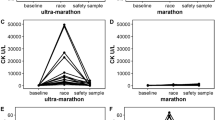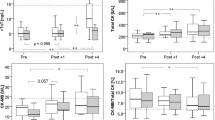Abstract
Introduction
An elevation of cardiac troponins has been described in healthy athletes after endurance exercises. The clinical significance of this increase is unclear and the lack of awareness of this phenomenon may lead to inappropriate management of these subjects.
Aim
We sought to determine wether an intensive cycling training could determine a biomarkers elevation.
Methods
We evaluated serum high sensitivity cardiac troponin T, NH(2)-terminal pro-brain natriuretic peptide, CK-MB and CK in 21 healthy male preadolescent athletes (age 9.2 ± 1.7 years) after an intensive cycling training prolonged until muscular exhaustion (mean duration 16′41″). During exercise heart rhythm and rate were monitored with Holter.
Results
62% of the group had an elevation of cardiac biomarkers: specifically, 6 children had an increase in troponin levels; 3 of them had an elevation of pro-brain natriuretic peptides as well. Pro-brain natriuretic peptides resulted increased in 9 subjects. There was no relation between troponin elevation and heart rate, age or exercise duration; subjects with increased pro-brain natriuretic peptides had mean and maximal heart rates lower than children with normal natriuretic peptides levels. Other sports were performed in 50% of subjects with normal troponins and only in 17% of those with increased values.
Conclusions
A short, high-intensity exercise caused an elevation of cardiac biomarkers in 62% of our subjects. The grade of training may influence the release of troponin and this increase is probably related to a temporary discrepancy between O2 delivery and consumption. Increases in natriuretic peptides levels are possibly expression of different adaptations to exercise.

Similar content being viewed by others
References
Cummins P, Young A, Auckland ML, Michie CA, Stone PC, Shepstone BJ. Comparison of serum cardiac specific troponin-I with creatine kinase, creatine kinase-MB isoenzyme, tropomyosin, myoglobin and Creactive protein release in marathon runners: cardiac or skeletal muscle trauma? Eur J Clin Investig. 1987;17(4):317–24. https://doi.org/10.1111/j.1365-2362.1987.tb02194.x.
Lippi G, Schena F, Dipalo M, et al. Troponin I measured with a high sensitivity immunoassay is significantly increased after a half marathon run. Scand J Clin Lab Invest. 2012;72(6):467–70. https://doi.org/10.3109/00365513.2012.697575.
Shave R, Dawson E, Whyte G, et al. The cardiospecificity of the third generation cTnT assay after exercise-induced muscle damage. Med Sci Sports Exerc. 2002;34(4):651–4. https://doi.org/10.1097/00005768-200204000-00014.
Tian Y, Nie J, Tong TK, Cao J, Gao Q, Man J, et al. Changes in serum cardiac troponins following a 21-km run in junior male runners. J Sports Med Phys Fit. 2006;46(3):481–8.
Regwan S, Hulten EA, Martinho S, et al. Marathon running as a cause of troponin elevation: a systematic review and meta-analysis. J Interv Cardiol. 2010;23(5):443–50. https://doi.org/10.1111/j.1540-8183.2010.00575.x.
Shave R, George KP, Atkinson G, et al. Exercise-induced cardiac troponin T release: a meta-analysis. Med Sci Sports Exerc. 2007;39(12):2099–106. https://doi.org/10.1249/mss.0b013e318153ff78.
Tian Y, Nie J, Huang C, George KP. The kinetics of highly sensitive cardiac troponin T release after prolonged treadmill exercise in adolescent and adult athletes. J Appl Physiol. 2012;113(3):418–25. https://doi.org/10.1152/japplphysiol.00247.2012.
Tanaka H, Monahan KD, Seals DR. Age-predicted maximal heart rate revisited. J Am Coll Cardiol. 2001;37(1):153–6. https://doi.org/10.1016/s0735-1097(00)01054-8.
Frassl W, Kowoll R, Katz N, Speth M, Stangl A, Brechtel L, et al. Cardiac markers (BNP, NT-pro-BNP, Troponin I, Troponin T), in female amateur runners before and up until three days after a marathon. Clin Lab. 2008;54(34):81–7.
Herrmann M. Post-race kinetics of cardiac Troponin T and I and N-terminal pro-brain natriuretic peptide in marathon runners. Clin Chem. 2003;49(5):831834. https://doi.org/10.1373/49.5.831.
Legaz-Arrese A, López-Laval I, George K, Puente-Lanzarote JJ, Moliner-Urdiales D, Ayala-Tajuelo VJ, et al. Individual variability in cardiac biomarker release after 30 min of high-intensity rowing in elite and amateur athletes. Appl Physiol Nutr Metab. 2015;40(9):951–8. https://doi.org/10.1139/apnm-2015-0055.
Lippi G, Impellizzeri F, Salvagno GL, Mion M, Zaninotto M, Cervellin G, et al. Kinetics of highly sensitive troponin I and T after eccentric exercise. Clin Chem Lab Med. 2010;48(11):1677–9. https://doi.org/10.1515/cclm.2010.308 (Epub 2010 Aug 13).
Nie J, Tong TK, Shi Q, Lin H, Zhao J, Tian Y. Serum cardiac troponin response in adolescents playing basketball. Int J Sports Med. 2008;29(6):449–52 (Epub 2007 Nov 14).
Scherr J, Braun S, Schuster T, et al. 72-h kinetics of high-sensitive troponin T and inflammatory markers after marathon. Med Sci Sports Exerc. 2011;43(10):1819–27. https://doi.org/10.1249/mss.0b013e31821b12eb.
Shave R, Ross P, Low D, George K, Gaze D. Cardiac troponin i is released following high-intensity short-duration exercise in healthy humans. Int J Cardiol. 2010;145(2):337–9. https://doi.org/10.1016/j.ijcard.2009.12.001.
George KP, Grant MC, Davies B, Baker JS. The impact of short duration, high intensity exercise on cardiac troponin release. Clin Physiol Funct Imaging. 2016;36(4):281–5. https://doi.org/10.1111/cpf.12225.
Eijsvogels TMH, Hoogerwerf MD, Maessen MFH, et al. Predictors of cardiac troponin release after a marathon. J Sci Med Sport. 2015;18(1):88–92. https://doi.org/10.1016/j.jsams.2013.12.002.
Serrano-Ostáriz E, Legaz-Arrese A, Terreros-Blanco JL, et al. Cardiac biomarkers and exercise duration and intensity during a cycle-touring event. Clin J Sport Med. 2009;19(4):293–9. https://doi.org/10.1097/jsm.0b013e3181ab3c9d.
Fortescue EB, Shin AY, Greenes DS, Mannix RC, Agarwal S, Feldman BJ, et al. Cardiac troponin increases among runners in the Boston Marathon. Ann Emerg Med. 2007;49(2):137–43, 143.e1 (Epub 2006 Dec 4).
Mingels A, Jacobs L, Michielsen E, Swaanenburg J, Wodzig W, Van DieijenVisser M. Reference population and marathon runner sera assessed by highly sensitive cardiac troponin T and commercial cardiac troponin T and I assays. Clin Chem. 2009;55(1):101–8. https://doi.org/10.1373/clinchem.2008.106427.
Shave R, Baggish A, George K, et al. Exercise-induced cardiac troponin elevation: evidence, mechanisms, and implications. J Am Coll Cardiol. 2010;56(3):169–76. https://doi.org/10.1016/j.jacc.2010.03.037.
Hickman PE, Potter JM, Aroney C, et al. Cardiac troponin may be released by ischemia alone, without necrosis. Clin Chim Acta. 2010;411(5–6):318–23. https://doi.org/10.1016/j.cca.2009.12.009.
Hessel MHM, Atsma DE, Van Der Valk EJM, Bax WH, Schalij MJ, Van Der Laarse A. Release of cardiac troponin I from viable cardiomyocytes is mediated by integrin stimulation. Pflugers Arch Eur J Physiol. 2008;455(6):979–86. https://doi.org/10.1007/s00424-007-0354-8.
Lippi G, Schena F, Salvagno GL, et al. Influence of a half-marathon run on NTproBNP and troponin T. Clin Lab. 2008;54(7–8):251–4.
Scharhag J, George K, Shave R, Urhausen A, Kindermann W. Exercise associated increases in cardiac biomarkers. Med Sci Sports Exerc. 2008;40(8):14081415. https://doi.org/10.1249/mss.0b013e318172cf22.
Scharhag J, Urhausen A, Schneider G, Herrmann M, Schumacher K, Haschke M, et al. Reproducibility and clinical significance of exercise-induced increases in cardiac troponins and N-terminal pro brain natriuretic peptide in endurance athletes. Eur J Cardiovasc Prev Rehabil. 2006;13(3):388–97.
Fu FH, Nie J, George K, Tong TK, Lin H, Shi Q. Impact of a 21-km run on cardiac biomarkers in adolescent runners. J Exerc Sci Fit. 2010;8(2):61–6. https://doi.org/10.1016/s1728-869x(10)60009-3.
George KP, Dawson E, Shave RE, et al. Left ventricular systolic function and diastolic filling after intermittent high intensity team sports. Br J Sports Med. 2004;38(4):452–6. https://doi.org/10.1136/bjsm.2003.004788.
George KP, Naylor LH, Whyte GP, Shave RE, Oxborough D, Green DJ. Diastolic function in healthy humans: non-invasive assessment and the impact of acute and chronic exercise. Eur J Appl Physiol. 2010;108(1):1–14. https://doi.org/10.1007/s00421-009-1233-0.
Neilan TG, Januzzi JL, Lee-Lewandrowski E, et al. Myocardial injury and ventricular dysfunction related to training levels among nonelite participants in the Boston Marathon. Circulation. 2006;114(22):2325–33. https://doi.org/10.1161/circulationaha.106.647461.
Nie J, George KP, Tong TK, Tian Y, Shi Q. Effect of repeated endurance runs on cardiac biomarkers and function in adolescents. Med Sci Sports Exerc. 2011;43(11):2081–8. https://doi.org/10.1249/mss.0b013e31821d4a82.
Tulloh L, Robinson D, Patel A, et al. Raised troponin T and echocardiographic abnormalities after prolonged strenuous exercise—the Australian Ironman Triathlon. Br J Sports Med. 2006;40(7):605–9. https://doi.org/10.1136/bjsm.2005.022319.
Siegel AJ, Silverman LM, Holman BL. Elevated creatine kinase MB isoenzyme levels in marathon runners. Normal myocardial scintigrams suggest non cardiac source. JAMA. 1981;246(18):204951.
Author information
Authors and Affiliations
Corresponding author
Ethics declarations
Financial support
This research received no specific grant from any funding agency, commercial or not-for-profit sectors.
Conflicts of interest
None.
Ethical approval
All procedures performed in studies involving human participants were in accordance with the ethical standards of the local Ethics Committee at ASST Grande Ospedale Metropolitano Niguarda, Milan (IT), and with the 1964 Helsinki declaration and its later amendments or comparable ethical standards.
Informed consent
Informed consent was obtained from all individual participants included in the study.
Rights and permissions
About this article
Cite this article
Peretti, A., Mauri, L., Masarin, A. et al. Cardiac Biomarkers Release in Preadolescent Athletes After an High Intensity Exercise. High Blood Press Cardiovasc Prev 25, 89–96 (2018). https://doi.org/10.1007/s40292-017-0243-y
Received:
Accepted:
Published:
Issue Date:
DOI: https://doi.org/10.1007/s40292-017-0243-y




